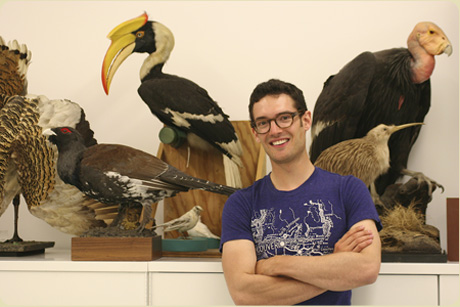
Daniel Field (Geology and Geophysics) is “passionate about the evolution of vertebrate animals” and spends much of his time photographing wildlife and collecting fossils. These activities provide “an endless source of research questions that help shed light on how and why Earth’s modern vertebrate biodiversity has come to be,” he says.
At Yale, Daniel has studied the evolution of a variety of creatures, including birds, whales, and turtles. Using fossils, computer models, and molecular data, he looks for “the patterns of evolutionary relationships among different animal groups, as well as the evolutionary acquisition of interesting biological features, such as bird flight.”
Recently, Daniel won the W.D. Hamilton Award from the Society for the Study of Evolution for his paleontological research on the origin of flight in birds, conducted in collaboration with Colton Lynner (Geology and Geophysics). They were among about 800 graduate students and postdoctoral fellows who presented work at the Evolution 2014 conference – the annual meeting of the Society for the Study of Evolution, the Society of Systematic Biologists, and the American Society of Naturalists.
The prize-winning talk, “Late Evolutionary Origin of Modern Bird Flight Inferred from Shoulder Allometry,” reported analysis of the transition from flightless dinosaurs to flying birds – a topic that has been “vigorously debated since the discovery of Archaeopteryx in the 19th century,” Daniel says. Allometry is the study of relationships between body size and an organism’s shape, anatomy, and behavior. In their work, Daniel and Colton quantified relationships between skeletal proportions and body size in modern birds, both flying and flightless, with a focus on the shoulder. They then applied these metrics to fossil birds and feathered dinosaurs to infer their original body mass and investigate the origin of avian flight.
The study revealed that “measurements of the shoulder provide excellent estimates of avian body size for flying birds — a result that makes sense, given that flying birds require robust shoulders to prevent failure of the joint during powered flight. We also discovered that flightless birds (ostriches, kiwis, and flightless rails) have substantially weaker shoulders than their flying counterparts. Based on the relationship between flying ability and shoulder dimensions in living birds, we were able to devise a biomechanical ‘test’ for fossil birds and feathered dinosaurs, to determine whether these long-extinct organisms” had shoulders that more closely resembled those of flying or flightless modern birds.

Daniel spent last summer on a joint Yale-American Museum of Natural History expedition in Colorado to look for skeletal fossils of small animals that lived 150 million years ago.
“When we investigated a wide range of feathered dinosaurs, including iconic fossils like Archaeopteryx, we were surprised to find that our new correlates of modern powered flying ability arose considerably later in avian evolutionary history than conventionally assumed, casting doubt on the modern aerial capacity of Archaeopteryx and many other early relatives of birds.”
This work will be part of Daniel’s dissertation, which is advised by Jacques A. Gauthier and tentatively titled, “Origin and evolution of the avian pectoral apparatus: implications for the acquisition of flight and flightlessness.”
Turtles are another group of organisms he has studied in detail. Evolutionary biologists argue about where turtles fit on the tree of life. A new study led by Daniel, published in the journal Evolution & Development, asserts that turtles are more closely related to birds and crocodiles than to lizards and snakes.
“Several studies purporting to investigate microRNAs misidentified other small RNA molecules as microRNAs,” Daniel found. “In our study, we collected new microRNA data from a variety of vertebrate animals and adhered to strict new guidelines for microRNA identification. When the experiment was redone, support for turtles as closer relatives of lizards and snakes turned out to be spurious, while support for turtles as closer relatives of birds and crocodilians was very strong.” He adds, “That common ancestor probably didn’t look anything like a modern bird or a modern crocodilian, but we know that it had to have existed. These divergences among the major groups of reptiles likely happened in the Permian, more than 250 million years ago.”
Daniel recently completed a pre-doctoral fellowship at the Smithsonian Institution’s National Museum of Natural History and spent the summer on a joint Yale-American Museum of Natural History expedition to the Jurassic Morrison Formation in Colorado. This area is one of the world’s most fertile sources of fossils, and some of Yale’s dinosaurs – animals like Allosaurus, Stegosaurus, and Apatosaurus (formerly Brontosaurus) were found there.
“Although the large, fearsome animals of the Morrison Formation are well known, little is understood about the smaller animals that lived alongside them at that time,” Daniel says. Millions of years ago, the site they worked in appears to have been a pond.
“What was probably the muddy bottom of this pond has become a fine-grained rock layer, and many small animals that settled at the bottom of the pond were entombed in this mud 150 million years ago. The fossilized skeletons of these animals are still there, waiting to be found, which is incredibly important because primitive early mammals, lizard-like animals, and even the early relatives of birds were around at that point in geological history,” he explains. “We were hoping to discover fossils bearing on the evolution of many different vertebrate groups; we discovered several fossils over the course of our time in the field, and their careful preparation and study will let us determine what they are, and what they tell us about vertebrate macroevolution.”
Originally from Calgary, Alberta, he earned his bachelor’s degree at the University of British Columbia in 2010 before beginning his doctoral work at Yale. When not on a dig or otherwise doing research, Daniel enjoys photography, literature, and music.